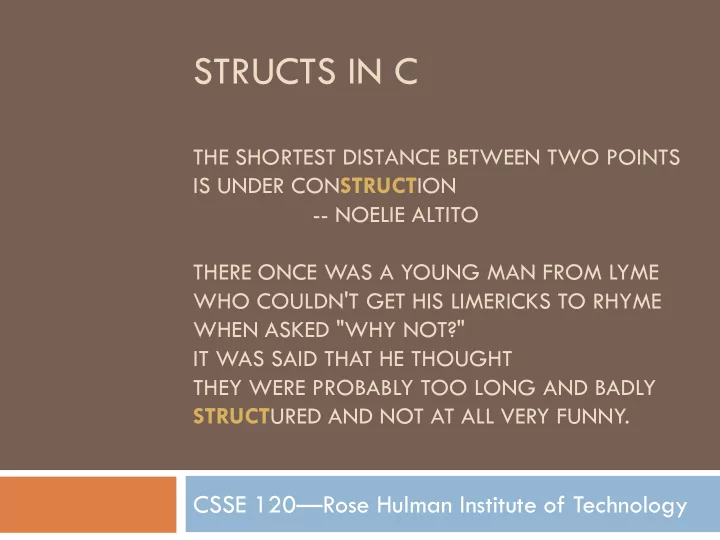

STRUCTS IN C THE SHORTEST DISTANCE BETWEEN TWO POINTS IS UNDER CON STRUCT ION -- NOELIE ALTITO THERE ONCE WAS A YOUNG MAN FROM LYME WHO COULDN'T GET HIS LIMERICKS TO RHYME WHEN ASKED "WHY NOT?" IT WAS SAID THAT HE THOUGHT THEY WERE PROBABLY TOO LONG AND BADLY STRUCT URED AND NOT AT ALL VERY FUNNY. CSSE 120 — Rose Hulman Institute of Technology
Preamble: #define and typedef C allows us to define our own constants and type names so that our programs can more easily say what we mean. #define TERMS 3 #define FALL 0 #define WINTER 1 #define SPRING 2 typedef int coinValue; coinValue quarter = 25, dime = 10; typedef int creditHours [TERMS]; creditHours susanHours; susanHours[WINTER] = 15;
The Object of structs No classes and objects in C. structs are the closest thing that C has to offer. Can't encapsulate data and operations together, as Python does in class definitions. No equivalent of self . Two ways of grouping data: Array: group several data elements of the same type. Access individual elements by position : student[i] Struct: group related data that may be of different types Access individual elements by name : endPoint.x
struct syntax struct <optional tag name> { <type_1> <fieldname_1> ; <type_2> <fieldname_2> ; . . . <type_n> <fieldname_n> ; } This says that each variable of this struct type has all of these fields, of the specified types. Structs are best declared in conjunction with typedef.
Example: Student struct type Declare the type: T o m O h typedef struct { char *name; 2009 int year; 3.68 double gpa; } student; Function to print a student's info: void printStudent(student s) { printf("[%s %d %1.2lf]\n", s.name, s.year, s.gpa); } Notice that once the type has been declared, it can be used in the same ways that a built-in type name is used.
Using the new type and function student tomas; Declare, initialize and print a tomas.name = "Tomas"; variable of type student . tomas.year = 2007; tomas.gpa = 3.4; printStudent(tomas); A shorter way! student jose = {"Jose", 2006, 2.8}; printStudent(jose); typedef struct { if (jose.year < tomas.year) char *name; printf("Jose is older.\n"); int year; else double gpa; printf("Jose is not older.\n"); } student; OUTPUT: void printStudent(student s) { [Tomas 2007 3.40] printf("[%s %d %1.2lf]\n", [Jose 2006 2.80] s.name, s.year, s.gpa); Jose is older. }
Get the Point? We define a point struct type, similar to Zelle's Point class in Python (but without the GUI). "Constructor" is not a C concept, but we can do something similar with a makePoint function. typedef struct { double xCoord; double yCoord; } point; point makePoint( double xx, double yy) { point p; p.xCoord = xx; p.yCoord = yy; return p; }
Go the Distance! In your C programming workspace, check out the StructsIntro project from your repository. Write a function distance that takes two point structs as its arguments, and returns the distance between them. Your code can call the following function:, which is provided for you. double square(double x) { return x * x; } Ask for help as needed!
Quick review of vectors A vector has magnitude and w direction. v Two vectors are equal if they have vectors v and w are equal. the same magnitude and direction. A vector can also be expressed in v terms of its x-component and y b j component: a i v = a i + b j , where a and b are its components of vector v components. (s, t) The vector from point (s, t) to point (u,v) is (u-s) i + (v-t) j . (u, v)
Some Vector Operations w Vector addition v+w v Translating a point by a If v = a i + b j and w = c i + d j , vector then v + w = (a+c )i + (b+d) j Length of a i + b j: (s, t) |v| = sqrt(a 2 + b 2 ) (s+a, t+b) a i + b j dot product: (a i + b j ) • (c i + d j ) = ac + bd
Add more struct types for each type, what should the fields be? segment – a line segment vector – there are two reasonable choices of how we could represent a two-dimensional vector line (no endpoints) Write the code together for these type declarations
Add additional functions together /* print the coordinates of p in fixed format. */ void printPoint(point p); /* return the point from first pointCount elements * of pList that is closest to the origin. */ point closestToOrigin(point pList [], int pointCount); /* Construct the vector from p1 to p2. */ vector makeVecFromPoints(point p1, point p2); /* Construct a line from a point and a vector. */ line makeLine(point p, vector v); /* Construct a line segment from its endpoints.*/ segment makeSegment(point p1, point p2);
A C Program in Multiple Files Check out the PointsLinesVectors project from SVN. A large program can be organized by separating it into multiple files. Notice the three source files: points-lines.h contains the struct definitions and function signatures used by the other files. point-line-functions.c contains the definitions of the functions that comprise operations on point, line, and vector objects. points-lines-main.c contains a main function to test the various functions. Both of the .c files must include the .h file.
Recommend
More recommend